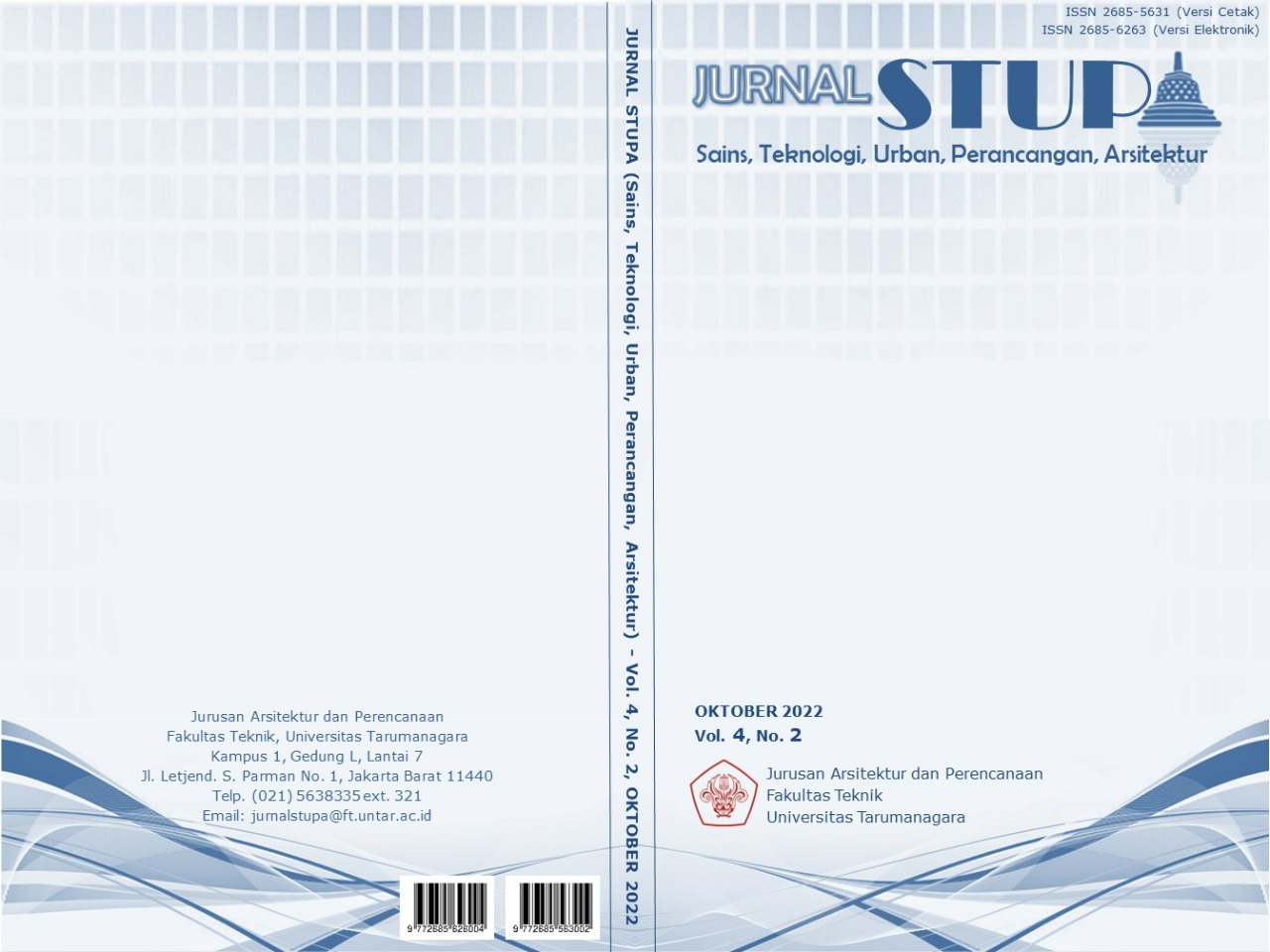PROSES PENGOLAHAN HASIL LAUT DI KAMAL MUARA: DIVERSIFIKASI OLAHAN IKAN, KULINER, DAN REKREASI
Main Article Content
Abstract
Kamal Muara is a coastal area of North Jakarta known for it’s busy harbor in 1960. At Kamal Muara, fishing boats land around the river, which empties into the north coast, forming a fishing village known for it’s Bugis solid culture. However, as the coastal areas of North Jakarta develop, the port of Kamal Muara and Kampung Nelayan has stagnated due to competition with neighboring ports such as Muara Angke and the negative impact of the development of Reclamation Island on the fishers' economy. Now the Fisherman's Village has developed into Rainbow Village along with the development of Kamal Muara into a tourist destination. Seeing the stagnation of the Kamal Muara area, a small-scale intervention using the urban acupuncture method is needed. This method analyzes regional factors and determines strategic steps to renew and rehabilitate the area. By utilizing the potential of Kamal Muara in the form of diversity in fishing catches and strategic locations on the transit route to the Thousand Islands, a marine product processing plant will be developed with the main function as a fish processing workshop and seafood restaurant. This location's development aims to improve the economy by providing employment opportunities, facilitating and diversifying local fish processing businesses, and providing recreational and culinary facilities that support the development of Kamal Muara as a tourist area. This design will be a step in reviving the Kamal Muara area.
Keywords: Diversify; Culinary; Fish Processing; Recreation; Urban Acupuncture
Abstrak
Kamal Muara merupakan daerah pesisir Jakarta Utara yang dikenal dengan pelabuhan yang cukup ramai pada tahun 1960. Di pelabuhan Kamal Muara perahu-perahu nelayan mendarat di sekitar kali yang bermuara di pantai utara, membentuk perkampungan nelayan yang dikenal dengan budaya Bugis yang kental. Namun seiring berkembangnya daerah pesisir Jakarta Utara, daerah pelabuhan Kamal Muara dan Kampung Nelayan mengalami stagnasi, dikarenakan kompetisi dengan pelabuhan sekitar seperti Muara Angke dan dampak negatif pengembangan Pulau Reklamasi terhadap perekonomian nelayan. Kini Kampung Nelayan telah berkembang menjadi Kampung Pelangi seiring dengan perkembangan daerah Kamal Muara menjadi daerah wisata. Melihat stagnasi kawasan Kamal Muara, maka diperlukan intervensi skala kecil dengan metode akupunktur perkotaan. Metode ini dilaksanakan dengan menganalisa faktor kawasan dan menentukan langkah-langkah strategis yang akan memperbaharui dan merehabilitasi kawasan. Dengan memanfaatkan potensi kawasan berupa keberagaman tangkapan nelayan serta lokasi strategis pada jalur transit pengunjung menuju Kepulauan Seribu, maka akan dikembangkan lokasi pengolahan hasil laut dengan fungsi utama sebagai workshop pengolahan ikan dan restoran laut. Pengembangan lokasi ini bertujuan untuk meningkatkan perekonomian masyarakat dengan menyediakan lapangan kerja, memfasilitasi dan melakukan diversifikasi usaha pengolahan ikan setempat serta menyediakan fasilitas rekreasi dan kuliner yang mendukung perkembangan Kamal Muara sebagai daerah wisata. Perancangan ini menjadi langkah dalam menghidupkan kembali kawasan Kamal Muara.
Article Details

This work is licensed under a Creative Commons Attribution-NonCommercial-ShareAlike 4.0 International License.
This work is licensed under a Jurnal Sains, Teknologi, Urban, Perancangan, Arsitektur/ STUPA Creative Commons Attribution-NonCommercial-ShareAlike 4.0 International LicenseReferences
Al-Hinkawi, W. Sh., & Al-Saadi, S. M. (2020). Urban Acupuncture, a Strategy for Development: Case Study of Al-Rusafa, Baghdad. IOP Conference Series: Materials Science and Engineering.
Ardakani, M. K., & Oloonabadi, S. S. A. (2011). Collective memory as an efficient agent in sustainable urban conservation. 2011 International Conference on Green Buildings and Sustainable Cities.
Benach, N. (2004). Public Spaces in Barcelona 1980-2000, in: (Ed) Transforming Barcelona: the renewal of a European metropolis, London: Routledge, p151-160.
Betweenarchitectureandurbanism, 2021. Shaping Identity of Tier-Two City Trough Collective Memory. Diunduh 14 Juli 2022, https://betweenarchitectureandurbanism.com/2021/05/20/shaping-identity-of-tier-two-citiy-through-collective-memory/
Casagrande, M. (2012). Bio Urban Acupuncture: From Treasure Hill Of Taipei To Artena, International Society of Bio urbanism, Rome, p.4-5.
Jolma Architects, 2018. Pocket Parks as Urban Acupuncture. diunduh 14 Juli 2022, https://land8.com/pocket-parks-as-urban-acupuncture/
Lerner, J. (2014). Urban Acupuncture, Washington, DC: Island Press/Center for Resource Economics, USA, p.160-163.
Lonelyplanet.com, diunduh 14 Juli 2022, https://lp-cms-production.imgix.net/2021-08/GettyImages-1266969151.jpg?auto=format&q=40&ar=16%3A9&fit=crop&crop=center&fm=auto&w=1946
Marcus, F. (2009). Handbook of Research on Urban Informatics: The Practice and Promise of the Real-Time City, Information Science Reference, IGI Global, Hershey, New York, p.17-19.
Morales, D. (2004). The Strategy of Urban Acupuncture: Structure Fabric and Topography Conference, Nanjing University, China, p.55-56.
Republika.co.id, diunduh 14 Juli 2022, https://statik.tempo.co/data/2014/01/16/id_255345/255345_620.jpg
Res.klook.com, diunduh 14 Juli 2022, https://res.klook.com/images/fl_lossy.progressive,q_65/c_fill,w_1295,h_720/w_80,x_15,y_15,g_south_west,l_Klook_water_br_trans_yhcmh3/activities/zcrg8szmdtntt6y1tapo/[LewatiAntrean]TheLouvreMuseumGuidedTour.jpg
Sassi, Paola. (2006). Strategies for Sustainable Architecture. New York: Taylor & Francis.
Tempo.co.id, diunduh 14 Juli 2022, https://statik.tempo.co/data/2014/01/16/id_255345/255345_620.jpg
Whitchurch, C. (2008). Shifting Identities and Blurring Boundaries: The Emergence Of Third Space Professionals In UK Higher Education. High education quarterly Vol. 62 Issue4, October Pages 377- 396.
Williams, Daniel E. (2007). Sustainable Design: Ecology, Architecture, and Planning. New Jersey: John Wiley & Sons, Inc.



